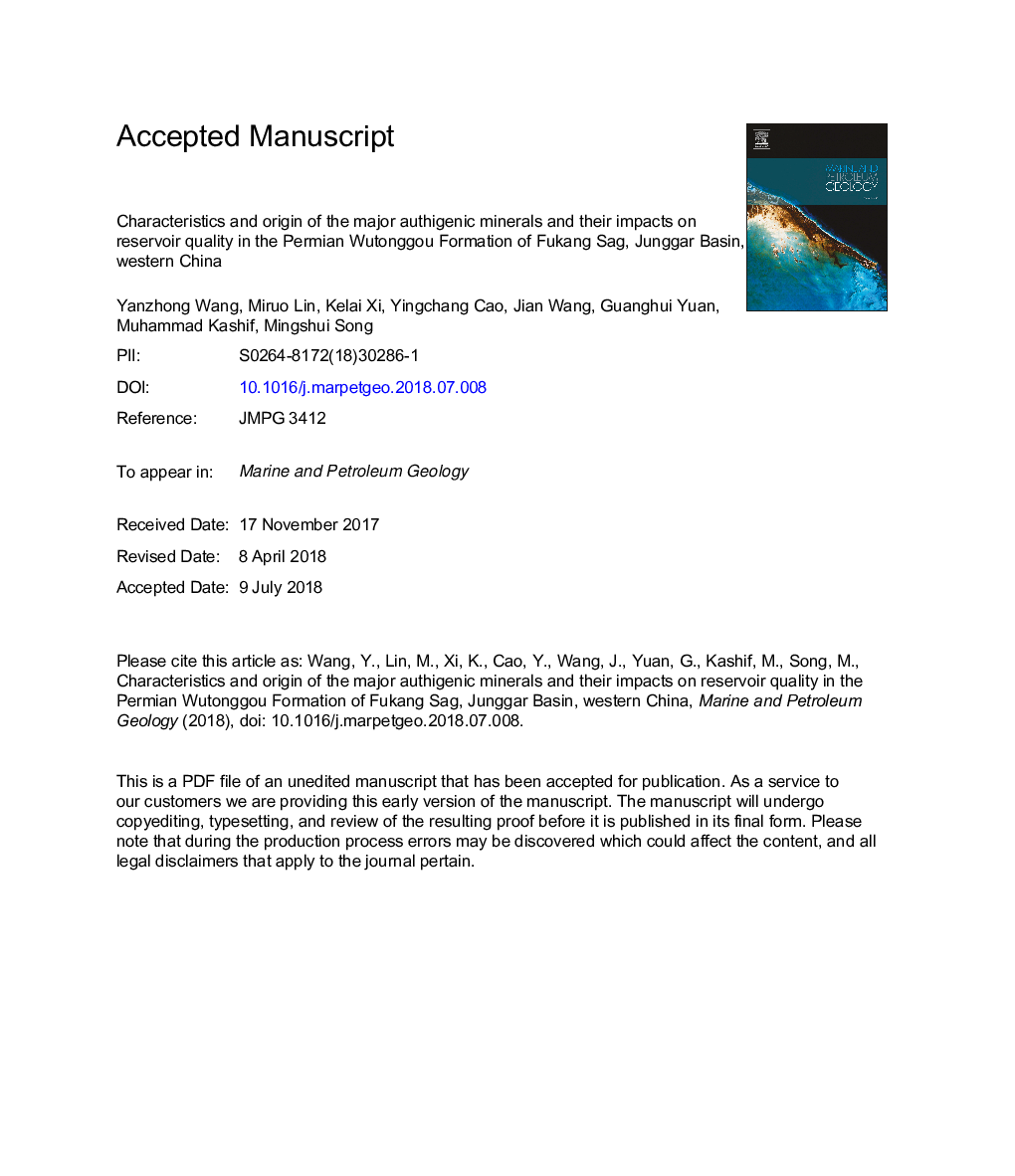| کد مقاله | کد نشریه | سال انتشار | مقاله انگلیسی | نسخه تمام متن |
|---|---|---|---|---|
| 8908961 | 1637128 | 2018 | 44 صفحه PDF | دانلود رایگان |
عنوان انگلیسی مقاله ISI
Characteristics and origin of the major authigenic minerals and their impacts on reservoir quality in the Permian Wutonggou Formation of Fukang Sag, Junggar Basin, western China
دانلود مقاله + سفارش ترجمه
دانلود مقاله ISI انگلیسی
رایگان برای ایرانیان
کلمات کلیدی
موضوعات مرتبط
مهندسی و علوم پایه
علوم زمین و سیارات
زمین شناسی اقتصادی
پیش نمایش صفحه اول مقاله

چکیده انگلیسی
This research is focused on the characteristics and origin of major authigenic minerals and the influences on the reservoir quality of the Permian Wutonggou Formation sandstones in the eastern slope of Fukang Sag, Junggar Basin, Western China. Authigenic cements were observed and described from thin sections, scanning electron microscopy, fluorescence, and cathodoluminescence. The elemental concentrations of the authigenic minerals were measured by electron probe microanalysis. Additional characterizations were obtained from O and C stable isotope ratios and from the homogenization temperature of aqueous fluid inclusions. The results show that the sandstones in the Wutonggou Formation are dominated by volcanic lithic fragments. Carbonates and laumontites are the major authigenic minerals in the study area. Authigenic quartz and kaolinite can also be observed. Two types of carbonate cements are identified. The first type is calcite with yellow fluorescent hydrocarbon inclusions. The carbon and oxygen isotopes in the calcites are highly C-depleted and O-depleted. The homogenization temperatures of the aqueous fluid inclusions in the calcite cements are higher than the highest paleogeotemperatures during the burial history. Combined with the presence of authigenic fibrous illites and the illitization of kaolinites, it is determined that the precipitation of the calcites is related to the upwelling of deep fluids and was impacted by the CO2 from the thermal decarboxylation of organic matters during the middle-late Jurassic. The second type is ferroan calcite with blue fluorescent hydrocarbon inclusions and higher contents of Fe, Mn, Cr, and Mg than in the calcites. The ferroan calcites in the Beisantai uplift are rich in 13C (δ13C (V-PDB) values are +22.10â° and +22.16â°). The precipitation of these ferroan calcites was impacted by the CO2 from crude oil biodegradation after the late Jurassic. Two types of laumontites are identified. The first type is partially dissolved and is characterized by a high Ca/Na ratio and low Fe contents. The second type is hardly dissolved, has hydrocarbon inclusions with yellow and blue fluorescence, and is characterized by a low Ca/Na ratio and high Fe contents. The first type of laumontite was precipitated prior to hydrocarbon charging and the second type was formed after hydrocarbon charging and meteoric water leaching. The hydration of the volcanic debris provided the source materials for both types of laumontite. The authigenic quartz and kaolinite were formed by the alteration of feldspars, laumontites, and volcanic materials. The evolution of the reservoir properties was impacted by various degrees of cementation and dissolution; as a result, the reservoir quality in the Beisantai uplift was better than in the Shaqiu area.
ناشر
Database: Elsevier - ScienceDirect (ساینس دایرکت)
Journal: Marine and Petroleum Geology - Volume 97, November 2018, Pages 241-259
Journal: Marine and Petroleum Geology - Volume 97, November 2018, Pages 241-259
نویسندگان
Yanzhong Wang, Miruo Lin, Kelai Xi, Yingchang Cao, Jian Wang, Guanghui Yuan, Muhammad Kashif, Mingshui Song,